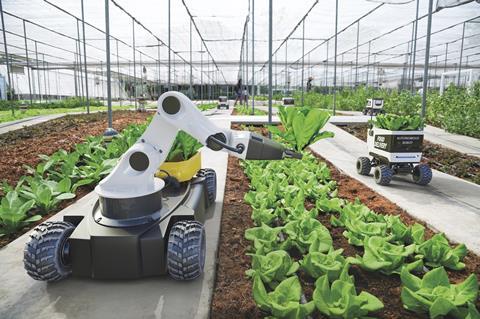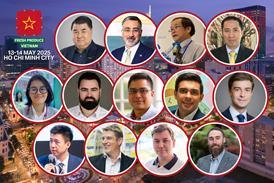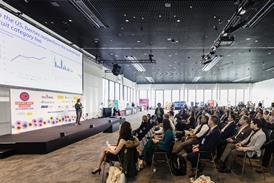Despite public fears over its impact, many believe we have still only caught a glimpse of artificial intelligence’s full potential in the fresh produce business
While the topic of artificial intelligence (AI) has shot back to the forefront of the world’s collective consciousness in recent months, it is an area that the fresh produce industry has looked to embrace for some time.

The arrival of ChatGPT and Bard in particular has reinvigorated the mainstream discussion around the opportunities – and potential pitfalls – of the power of AI, but many in the fruit and vegetable business already espouse the benefits in areas such as robotics, crop monitoring, machinery, and communications.
At this year’s Global Tomato Congress, which took place in Rotterdam on 16 May, agtech startup Source.ag’s co-founder and CEO Rien Kamman spoke enthusiastically about the benefits of AI and downplayed some of the fears that exist over its adoption.
“AI has the potential to empower growers, who wield tremendous power, have an enormous responsibility and do a complex job,” said Kamman. AI was being utilised in a number of key areas in the fruit and vegetable supply chain, he outlined, including smart monitoring for full, real-time visibility (remotely or in person), assessing sales, planning labour, monitoring strategy and risk, and executing plans autonomously.
“Growers are three-dimensional chess players,” he continued. “You need to find the right strategy across these multiple dimensions – pruning, costs, irrigation and more – and every day you are presented with new information. This is where AI plays a massive supporting role.”
Strategic choices
Kamman said Source.ag’s early adopters completed “hundreds” of simulations every week as new information came in and altered their strategies accordingly.
“You need a good digital representation of what is happening in the greenhouse, a virtual overview,” he said. “The AI can simulate the actual biology of crops, to see how different strategies can affect the outcome. If you do this virtually, you can do it in seconds without any risk to the actual operation. We simulate strategies, simulate the biology, the production. You can model how good a strategy is from a financial point of view too, how much revenue will it bring in, how much profit.”
Kamman was also keen to point out that, while he understood the concerns surrounding the rapid development of AI and the perception it could usurp some in the supply chain, this was not the end goal.
“AI is a partner to help growers, not replace them, it is designed to help find the best solutions to help the business,” he explained. “It will reduce risk and help produce more food through expanded and more efficient production.
“There is uncertainty about the future when we speak to growers about AI, but there are so many jobs that they undertake that it is about benefiting them, making their life easier,” he added. “There is also an education aspect to this – a lot of the narrative around AI is driven by the media and it is important that the facts and nuances are made clear, as AI and its use is not so black and white.”
Robotic applications
The advantages offered by AI are also championed by Itamar Zisling, business development and pilots manager at robotics developer Metomotion, who pointed to the numerous challenges being faced by those producing in greenhouses.
“Labour price and availability, energy crisis uncertainty and the market itself with people wanting more for less with better quality and variety are all considerations,” Zisling told the Global Tomato Congress. “Robots are here and they will help tackle not only the widespread labour issues but the others mentioned with advanced AI and technology.
The mechanical arms of Metomotion’s Greenhouse Robotic Tomato Harvester can detect, approach and harvest vines. They promise potential labour cost savings of 50 per cent, with an overall labour reduction of 80 per cent, and therefore offer a glimpse of a more efficient and cost-effective process.
“What does the future look like?” Zisling asked. “The technology of AI is already available and it allows us to go to the next level - not replacing people in the greenhouse but adding to them. AI offers new ways of working and new insights.”
Level of control
For David Meszaros, founder and CEO of Dutch company Smartkas, which builds climate-neutral fruit and vegetable production centres that embrace a wide range of new technologies, AI will be more useful in some situations, less so in others.
“I would say that AI can have far more radical and extreme applications in open-field farming, less in greenhouses, and almost nothing in vertical farms,” he outlines. “That’s because the level of control increases in greenhouses and even more so in vertical farms, therefore the variables narrow down.
If there are no variables, he says, all of the parameters are known exactly. “Like the PPFD [photosynthetic photon flux density] of the light, or the co2 ppm [parts per million]. So what is there for the AI to think about?”
Out in a more natural environment, however, Meszaros believes there is huge potential. “AI can thrive in open field, where there are insects, birds, rain, and so on,” he suggests. “There, with a predictive algorithm, it can start modelling, because everything changes all the time.”
In practice, this would be achieved through the installation of systems like low-frequency ground sensors, GPS-controlled tractors and other automated units, and drones. “But I’m not talking drones for irrigation and pest control,” he explains. “Drones can help create something called an orthomosaic, a stitched-together array of 4K images. This is almost true AI, which creates an accurate live map of your farm. It can use all kinds of inputs to create a model that shows where your farm is most fertile, where it has a hotspot for bees, for flies, for birds, for whatever. And then you don’t have to spend millions on pesticides and all kinds of preventive measures.”
Huge impact
Ultimately, the question remains: how will AI benefit the industry in the long-term? Juan González Pita, chief operating officer at Argentinean group Salix Fruits, feels that it is going to have a huge impact on how fresh produce companies operate day-to-day.
“AI such as ChatGPT is helping us to refine the way we communicate with our stakeholders, either via the press or even with our social media,” Pita tells Fresh Focus Packaging and Technology. “Our language now is more consistent with the way we want to say things. AI-powered solutions can definitely help to reduce a company’s environmental impact and increase sustainability, but it needs still a lot of data input from the industry and also watchdogs to audit results.
“I don’t see ethical concerns per se, but I do know this is going to affect how each and all of us work on a daily basis,” he continues. “It reminds me of 20 years ago when the internet boomed and all of a sudden communications were faster than ever, and this left a lot of people behind. This feels pretty much the same. That is why I try to understand, to some extent, what the heck this AI thing is, and how it can affect our business.”






